Insulating your outside drain pipes protect your plumbing system and prevent costly repairs. Cold weather can cause water in the pipes to freeze, leading to burst pipes and water damage.
Furthermore, insulating the pipes helps maintain a consistent temperature, reducing the risk of freezing. In addition to protecting your pipes, insulating your outside drain pipes can also improve your home’s energy efficiency.
Keeping the water in the pipes warmer can reduce the energy needed to heat the water, resulting in lower energy bills. In this article, we will provide step-by-step instructions on how to insulate your outside drain pipes properly.
Do Drain Pipes Need To Be Insulated?
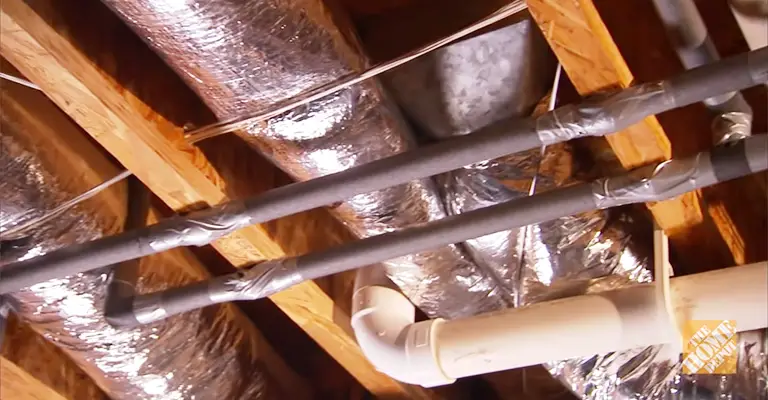
In most cases, drain pipes do not need to be insulated. The main function of drain pipes is to transport wastewater and other substances away from a building, and insulation is not typically necessary for this purpose.
However, there may be some situations in which it makes sense to insulate drain pipes.
For example, if the pipes are located in an unheated space such as a crawl space or basement, insulating the pipes can help to prevent freezing during cold weather.
Frozen pipes can burst and cause severe damage to a building. In addition, insulating drain pipes can help reduce the amount of noise transmitted through the pipes.
This can be especially helpful if the pipes are located in a living area of a building.
Overall, whether or not to insulate drain pipes will depend on the installation’s specific circumstances and the building’s needs. It may be worth considering insulating the pipes in certain cases, but it is not necessary in most cases.
Outside Drain Pipe Insulation Methods and Materials
Here is a list of materials you might need for an insulation project, depending on what type of pipes you’re covering:
- The type of insulation you prefer (pipe sleeve, pipe wrap, outdoor faucet cover)
- Expanding spray foam
- Foam caulk rope
- Duct tape
Outdoor Faucet Covers
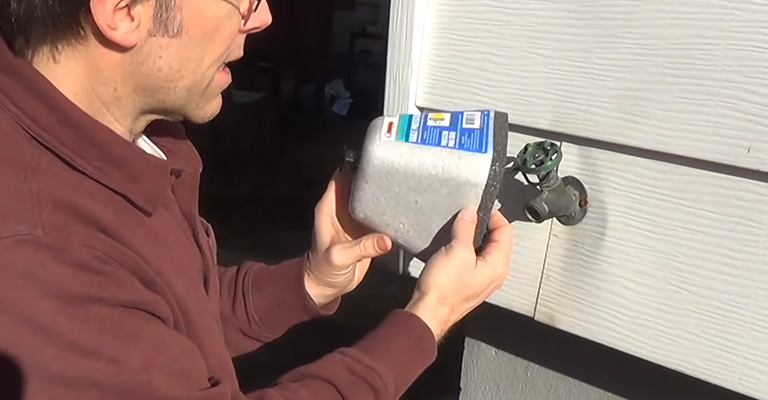
An outdoor faucet hard foam cover provides a simple way to prevent ice chunks from falling from your roof and eaves.
It is possible to purchase faucet covers from most hardware stores or online. You can install your faucet cover by following these steps:
- Place the rubber loop around the spigot.
- First, detach your hose from the faucet and put it in a safe spot for the winter.
- Tighten the slide lock to hold the cover in place. Make sure there are no air gaps.
- Position the cover over the spigot.
Pipe-Wrap Insulation
Small pipe lengths are recommended for insulation with pipe wrap, which is easy to install.
There are different types of pipe insulation tape, including flexible foam with rubber backing, foam-and-foil tape, bubble-film pipe wrap, foil-backed natural cotton wrap, and rubber-backed pipe insulation tape.
Installing pipe-wrap insulation tape involves the following steps:
- Using the insulating wrap, attach one pipe end to the loose end.
- Make sure to wrap it around the pipe in spiraling loops to cover the entire pipe.
- As soon as enough insulating wrap has been applied, cut the end off.
Foam Pipe Sleeves
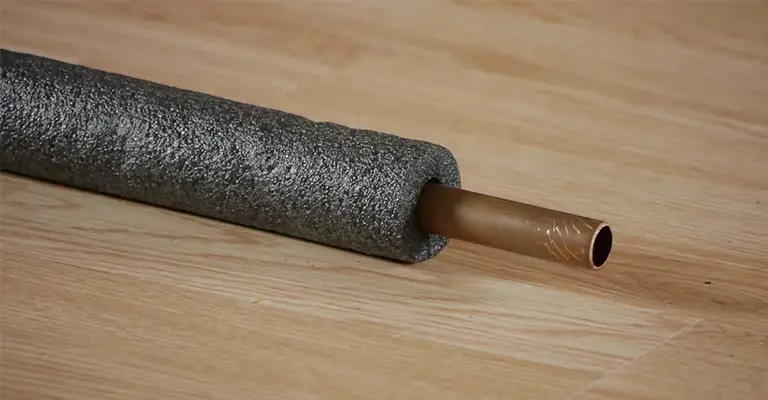
In terms of insulation methods, foam pipe sleeves are one of the easiest. This is a good option if you need to cover longer, straight pipes.
The diameter of sleeves varies according to the pipe size and can be purchased in increments of six feet.
The following are the steps for installing a foam pipe sleeve:
- Make sure the sleeve is positioned along the pipe.
- Make sure the pipe is covered by opening the sleeve slit.
- Using the adhesive or duct tape provided, seal the seam.
- Measure the pipe’s length and cut the sleeve accordingly.
Pre-Insulated Pipes
It is also possible to install pre-insulated sewer pipes, which is only helpful if you replace old ones. Pipes that are pre-insulated are usually covered with foam and encapsulated in some type of sleeve.
Depending on the product, it can be expensive to install them, deeper trenches may also need to be dug for installation.
New builds, however, can benefit from them; they will protect your pipes at all temperatures and prevent problems later.
Additional Winter Pipe Protection Tips
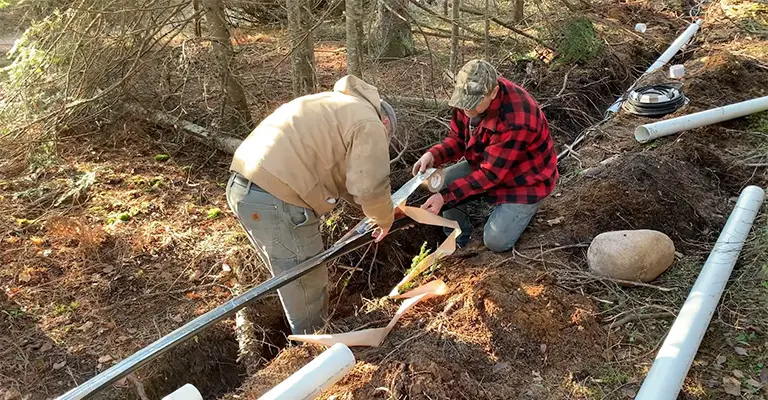
Whatever type of pipe insulation you choose, ensure your pipes are well protected during winter. Before the first hard freeze, stop the water flowing from outdoor faucets and open the spigots to drain the pipes.
If the outdoor water supply can’t be shut off, run your spigots occasionally through the winter to ensure the water pressure is normal.
How to Insulate PVC Sewer Pipes?
The pipes in sewer systems do not hold any standing water, so insulation is usually unnecessary. There are cases where insulation is warranted if the line runs near a wall that is not insulated or if the line is exposed to extreme cold.
In addition to deadening the sound of running water, insulation will also dampen the vibrations caused by the pipe.
Using standard fiberglass wall insulation will provide more protection than using polyethylene foam insulation when insulating PVC pipes. If you are handling fiberglass insulation, don’t forget to wear gloves. It can cause skin irritation.
Things You’ll Need
- Gloves
- R16 Fiberglass Wall Insulation
- Utility Knife
- Plastic Sheeting
- Duct Tape
- Tape Measure
Step 1
Using a measuring tape, measure the sewer pipe length and cut the insulation length to match.
Step 2
PVC sewer pipes should have an insulation strip installed on top of them.
Step 3
Ensure that the insulation edges overlap as you wrap them around the pipe. Use duct tape to secure the insulation edges to the pipe.
Apply a piece of tape to the seam or edges of the insulation once the pipe is covered with insulation. You shouldn’t compress the insulation since the air spaces within the fibers do the actual “insulation.”
Step 4
Seal the edges of the plastic with tape, wrap the insulation in plastic sheeting to prevent moisture buildup, and wrap it in plastic sheeting to prevent moisture buildup.
Where to Insulate Water Pipes?
Insulation is not only required for outdoor water pipes, as many homeowners assume. The statement is partially true.
Your home is at risk if your pipes are not well insulated and in an unheated space, such as an exterior wall, basement, attic, or crawl space.
Additional insulation is not necessary for all other interior pipes exposed to heated areas. It is beneficial to insulate your water pipes for several reasons, including:
- Keep your pipes from freezing and bursting
- You’ll save money and energy
- Heat loss can be mitigated
- Keep condensation away
- Reduce contractions and expansions
- The hot- and cold-water pipes can both be insulated to get those benefits.
Hot Water Pipes
Insulating your hot water pipes is a great idea to reduce your energy costs. To begin with, it prevents heat loss, so your hot water stays hot. It’s important to consider this if you have a traditional tank-style water heater.
Having already paid to heat it, you don’t have to reheat it often due to cooling, so minimizing heat loss saves you money and energy.
Furthermore, hot water pipe insulation can raise the temperature of your water without turning up the water heater, which is another way to save money.
In addition to saving water and energy, it also saves money. The higher temperature means the water heats up faster for bathing, showering, or washing dishes.
The sound of running hot water can sometimes be loud, particularly in older homes. To reduce the noise generated by the expansion of metal pipes, it is possible to insulate them.
Cold Water Pipes
Water pipes that carry cold water do not need to minimize heat loss; they can sweat when it is humid. A basement with little insulation can experience increased humidity due to condensation buildup.
It shouldn’t add much to your budget to have your cold-water pipes insulated if you have already hired a professional to insulate your hot water pipes. If the temperature falls below freezing in unheated areas, pipes may freeze.
Nevertheless, they can also be subject to a high temperature due to the same lack of temperature control which causes them to freeze.
Because of this, Phoenix, AZ, and its surrounding valley areas can get quite hot during the summer. Different problems can result from that.
You don’t want to turn on your faucet to get a glass of warm water instead of a cool, refreshing drink. Cool water can stay cool longer if your cold-water pipes are insulated.
In the same way you don’t waste water waiting for hot water to warm up, you can also save water by preventing hot water from turning cold.
You can also avoid condensation when you insulate cold water pipes in areas that are not temperature controlled. Metal pipes can sweat if they are exposed to high temperatures and humidity.
A condensation problem can lead to water from pipes in the attic falling onto your ceiling because condensation must go somewhere. As a result, stains occur or, in severe cases, holes form, which put anything underneath at risk.
Why Do Pipes Freeze?
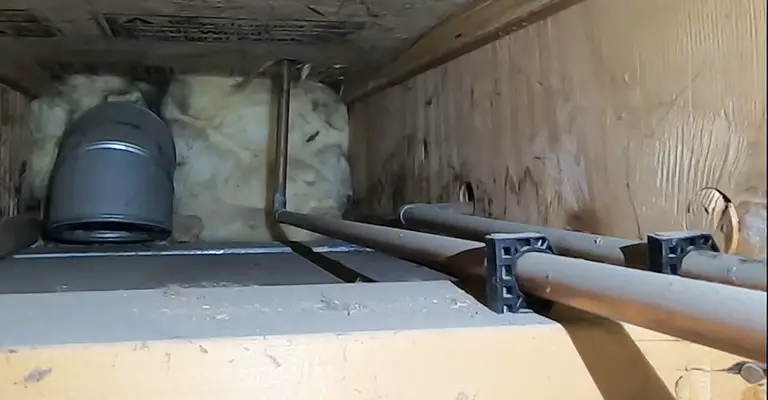
Low temperatures can cause freezing in any conduit that transports or holds water. What are the problems with that?
Water that has frozen expands. Under strain, pipes crack or burst due to the pressure from the expansion because they are not elastic.
You should wear an insulated coat, hat, and mittens when the weather gets cold. In freezing temperatures, hypothermia and frostbite aren’t guaranteed to disappear, but they are drastically reduced.
Your water pipes become less susceptible to cracking and breaking if insulated, reducing the possibility that ice will form inside them. Upon thawing, water damage results. To prevent damage, you must stop it before it begins.
Which Pipes Need Insulation?
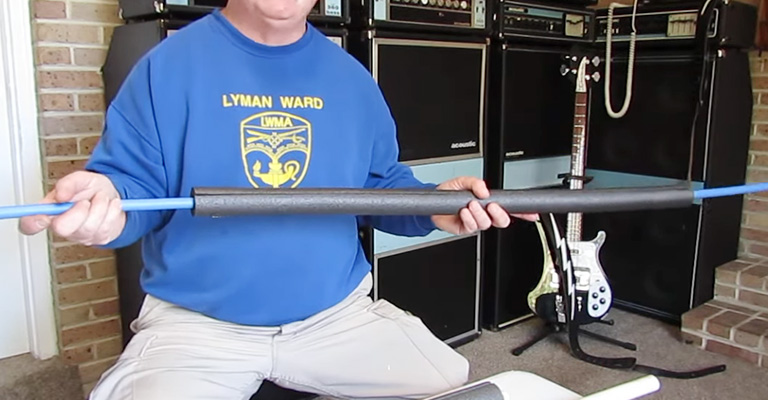
An ice buildup inside a pipe can cause it to burst when water freezes inside it. You’ll face fast and furious flooding if a pipe bursts on your property.
You know how important it is to avoid freezing pipes during the winter, particularly if you’ve ever suffered a pipe burst in winter.
It prevents hot water pipes from losing their heat by insulating and lowering their exposure to the elements.
Insulating pipes also saves you money by reducing the chance of disaster. Generally, homeowners believe that the only lines that require insulation are those outside their homes, such as pipes and faucets.
Any exposed and poorly insulated pipe in your home, including those in unheated places such as exterior walls, garages, attics, basements, and the floors above unheated crawl spaces, can benefit from insulation.
Final Words
Your sewer pipes must be kept warm in the winter to prevent freezing. Backups and even burst sewer pipes are possible when sewer pipes are frozen. Insulating pipes is a great way to prevent them from freezing.
Whatever the weather, it’s always important to ensure your sewer pipes are in good shape and ready to handle whatever comes their way. It is easier to solve sewer system problems if you pay more attention to preventative maintenance.







